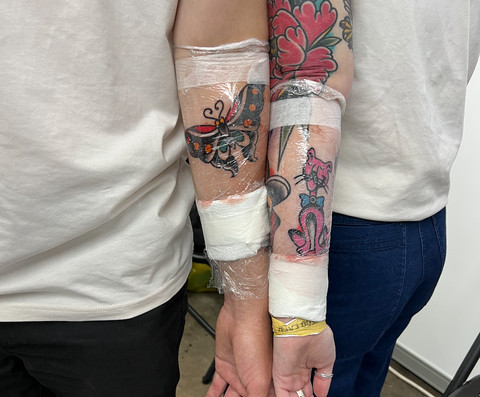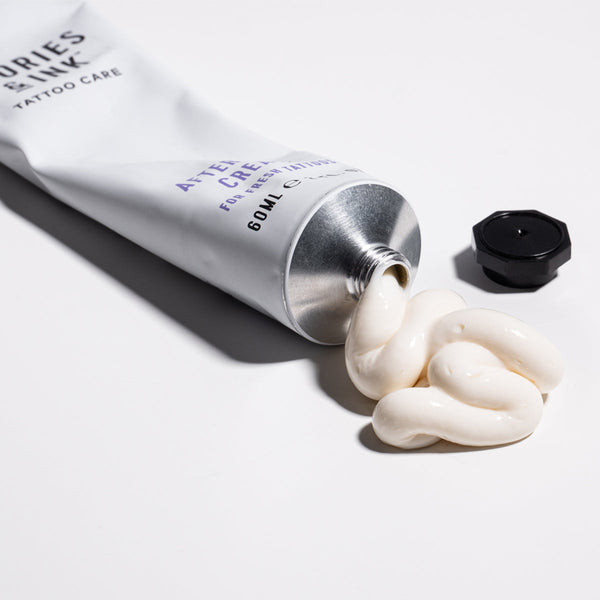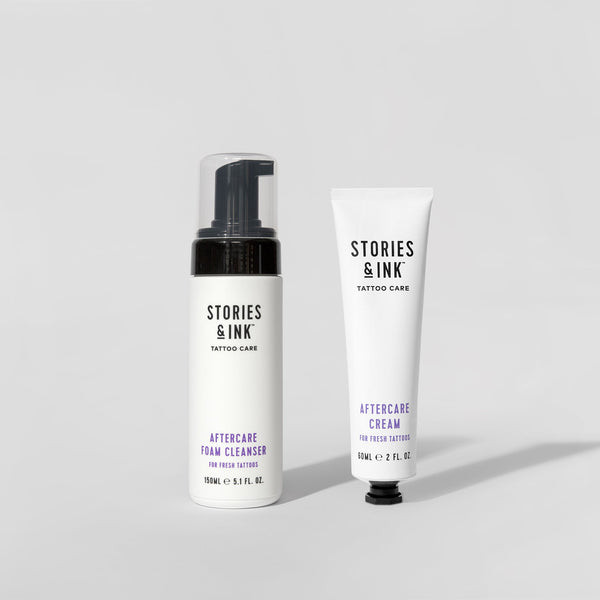Tattoo healing times can vary, but generally, it takes two to four weeks for a new tattoo to heal, and tattooat.com is here to guide you through each stage of the process for a vibrant and healthy result. Understanding the healing timeline, potential complications, and proper aftercare is crucial for ensuring your body art remains a stunning expression of yourself. Explore tattoo aftercare, tattoo healing stages, and tattoo infection signs with us.
1. Understanding the Tattooing Process
To better understand the healing process, it’s helpful to know what happens when you get a tattoo.
Liv Dodds, a tattoo artist from Northumberland, UK (@livdoddstattoo on Instagram), explains: “In simple terms, your skin has three layers: the epidermis, the dermis, and the hypodermis/subcutaneous layer. During a tattoo session, the ink enters the dermis, where your body recognizes it as a wound. Your body then sends white blood cells (macrophages) to ‘destroy’ the ink. The macrophages remain in the dermis with the ink pigments, creating your tattoo. Only about 1/16th of an inch enters the skin, which can be punctured up to 3,000 times per minute.”
This process essentially creates a controlled injury, and the healing process is your body’s natural response to repair that injury.
2. The First 24 Hours: Critical Initial Care
The initial 24 hours after getting a tattoo are crucial for setting the stage for proper healing.
 Cling film
Cling film
Liv Dodds emphasizes, “Some swelling, redness, and general irritation are normal after a fresh tattoo. At the end of your session, your artist will cover your tattoo with either cling film or a second skin. It’s best to consult your artist on how long to leave this covering on, as each one will have different advice.”
Second skin is becoming increasingly popular, and Liv recommends leaving it on for up to 12 hours before removal. After removing the covering, she suggests a “wet heal” process, washing the tattoo two or three times a day and applying aftercare products.
Liv stresses the importance of keeping the tattoo clean and fresh during the first 24 hours. “This means no touching it (not even your friends/family when you show it off), and keeping it wrapped to eliminate as much bacteria as possible. Washing your tattoo regularly during this process will also keep it nice and cool, as it may feel quite hot for the first few hours.”
3. Tattoo Healing: Essential Tips from a Pro
Here are some crucial do’s and don’ts from Liv to aid in your tattoo’s healing:
3.1. Do’s
- Wear Loose Clothing: Choose loose clothing for your appointment that won’t rub against your new tattoo.
- Keep It Clean and Moisturized: Use only natural or tattoo-friendly products to keep the area clean and moisturized.
- Let It Breathe: Allow the tattoo to breathe by avoiding occlusive bandages after the initial protection period.
3.2. Don’ts
- Submerge in Water: Avoid baths, pools, and the sea while your tattoo heals; showers are fine.
- Let Pets Interact: Don’t let pets rub against or lick the tattoo.
- Heavy Exercise: Avoid heavy exercise for at least 48 hours to minimize sweating and friction.
- Pick At It: Refrain from picking at scabs.
- Expose to Direct Sunlight: Keep your tattoo out of direct sunlight.
4. How Long Does Tattoo Healing Take?
Healing times can vary from person to person, but here’s a general guideline.
Dr. Nicolas Kluger (@the_tattooed_derm on Instagram), a professor of Dermatology at Helsinki University Hospital, states, “Broadly speaking, the healing takes two to four weeks. Usually, if the tattoo hasn’t healed within a month, there is another problem, like an allergy or infection.”
The type of tattoo can also influence healing time. According to Nicolas, “Light tattoos (drawings) will heal faster than tattoos with large areas covered by color. An eyebrow made by microblading will also heal quite fast. But one month is a safe limit to say whether there’s a problem or not.”
While the location of the tattoo generally doesn’t affect healing speed, Nicolas notes that “if you get a tattoo on an area of constant rubbing, like an ankle on a shoe, and you don’t keep resting it, this may impact healing.”
5. The Impact of Medication on Tattoo Healing
Certain medications can affect how quickly your tattoo heals, so it’s important to be aware of potential interactions.
Nicolas advises, “I discourage people from getting tattoos while on isotretinoin (a treatment for acne) because of possible delays in healing, or high doses of corticosteroids (a type of anti-inflammatory drug).” However, he adds, “For diabetic patients, there is no reason to be concerned if the diabetes is well controlled during tattooing.”
6. Tattoo Healing Stages: A Week-by-Week Breakdown
Your tattoo will go through several noticeable changes as it heals. Here’s a timeline of what to expect:
6.1. Week 1
After removing the initial wrap, it’s normal to see redness, slight inflammation or swelling, some oozing, or a burning sensation. Avoid re-covering the tattoo, as this can trap moisture and affect healing.
6.2. Week 2
This is when the tattoo can get itchy as the skin begins to flake and scab. Avoid picking at scabs or scratching, as this can prolong healing and cause scarring. It’s also normal for some ink to appear to be coming off during this stage.
6.3. Weeks 3 and 4
Your new ink may appear less vibrant due to a layer of dry skin forming over the tattoo. This will naturally exfoliate over the next week or so, revealing the vibrant tattoo underneath. Most of the itchiness should subside during this stage. If redness or swelling persists, it could be a sign of infection.
6.4. From 1 to 6 Months
After a month, any itching and redness should be completely gone, and the tattoo may look fully healed. However, the skin under the tattoo can continue to repair itself for up to six months. Continue your aftercare routine during this period.
 Stories & Ink Aftercare Cream
Stories & Ink Aftercare Cream
7. Recognizing the Signs of Tattoo Infection
While severe reactions are rare, it’s important to know the signs of infection or allergic reaction. Seek medical assistance if you have any concerns.
| Sign | Description |
|---|---|
| Redness that doesn’t go away | Redness lasting more than a few days could indicate improper healing. |
| Skin feels hot | Radiating heat days after getting your tattoo could be a sign of infection. |
| Oozing fluid | Fluid or pus coming out two or three days after getting inked may indicate a problem. |
| Fever or chills | A common sign of infection that warrants medical attention. |
| Pain gets worse | If the pain intensifies days after getting inked instead of improving, it could be a sign of infection. |
| Swollen, puffy skin | Excessive swelling around the tattoo area may indicate an allergic reaction to the ink. |
| Severe itching or hives | Really itchy tattoos or hives may suggest an allergic reaction. |
8. Tattoo Healing: Frequently Asked Questions (FAQ)
8.1. How long does a tattoo take to heal completely?
Generally, it takes two to four weeks for a new tattoo to heal. If it hasn’t healed within a month, consult a professional.
8.2. What does a healing tattoo look like at each stage?
Initially, expect redness, oozing, and swelling. After two weeks, the skin may peel. In weeks three and four, the tattoo may appear dull until the skin exfoliates, revealing the vibrant color.
8.3. What should I put on a healing tattoo?
Consult your tattoo artist for specific recommendations. Stories & Ink’s Aftercare Cream is designed to soothe and repair damaged skin immediately after tattooing.
8.4. Can I put sunscreen on a healing tattoo?
No, avoid sunscreen until the tattoo is fully healed, as it contains ingredients that can irritate the skin. Cover up with loose clothing when exposed to the sun.
9. Discover Your Next Tattoo at tattooat.com
Looking for inspiration for your next tattoo? Or maybe you’re searching for a talented tattoo artist in the US? Look no further than tattooat.com! Our website is dedicated to connecting you with the best tattoo designs, artists, and studios across the country.
9.1. A Vast Library of Tattoo Designs
Whether you’re into traditional Americana, intricate Japanese designs, or modern minimalist art, tattooat.com offers a diverse collection of tattoo designs to spark your creativity.
9.2. Find the Perfect Artist for Your Style
Our curated list of tattoo artists features some of the most talented and experienced professionals in the industry. Browse their portfolios, read reviews, and find an artist whose style aligns with your vision.
9.3. Learn Everything You Need to Know About Tattoos
From detailed guides on aftercare to in-depth articles on tattoo history and styles, tattooat.com is your go-to resource for all things tattoos.
10. Ready for a Seamless Tattoo Healing Journey?
Navigating the tattoo healing process doesn’t have to be daunting. With the right knowledge and products, you can ensure your tattoo heals beautifully, preserving its vibrancy and detail for years to come.
 Stories & Ink Aftercare Duo
Stories & Ink Aftercare Duo
The Stories & Ink Aftercare Duo, featuring the gentle Aftercare Foam Cleanser and hydrating Aftercare Cream, is perfect for cleansing and healing fresh tattoos. It’s 100% natural, dermatologically-tested, fragrance-free, hypoallergenic, vegan-friendly, and suitable for all skin types. The duo keeps fresh tattoos clean, nourishes, hydrates, reduces inflammation, and helps skin heal faster. Use it for the first few weeks of healing for the best results.
Explore more top tattoo care products by shopping the full range now!
Address: 1825 SW Broadway, Portland, OR 97201, United States
Phone: +1 (503) 725-3000
Website: tattooat.com
Ready to explore a world of tattoo inspiration and connect with talented artists? Visit tattooat.com today and let us help you find the perfect design and artist for your next masterpiece. Whether you’re a first-timer or a seasoned tattoo enthusiast, we have something for everyone. Discover the art, the culture, and the community of tattoos with tattooat.com.
11. Key Factors Affecting Tattoo Healing Time
Several factors influence the duration of the tattoo healing process. Understanding these can help you optimize your aftercare routine and minimize potential complications.
11.1. Tattoo Size and Complexity
Larger and more intricate tattoos generally take longer to heal than smaller, simpler designs. The greater the area of skin that has been traumatized, the more time your body needs to repair it. Tattoos with heavy shading or color packing also tend to require a longer healing period.
11.2. Tattoo Placement
The location of your tattoo significantly impacts healing time. Areas with high friction, such as hands, feet, and joints, are prone to irritation and may take longer to heal. Tattoos in areas with less blood flow, like the ankles, can also experience slower healing.
11.3. Skin Type and Health
Your individual skin type and overall health play a crucial role in the healing process. People with sensitive skin may experience more inflammation and require extra care. Conditions like eczema or psoriasis can also complicate tattoo healing. A healthy immune system is essential for efficient healing, so ensure you’re getting enough sleep, eating a balanced diet, and staying hydrated.
11.4. Aftercare Practices
Proper aftercare is paramount for successful tattoo healing. Following your artist’s instructions diligently can significantly reduce healing time and minimize the risk of infection. Consistent cleaning, moisturizing, and protection from the sun are essential.
11.5. Artist Skill and Technique
The skill and technique of your tattoo artist also influence healing time. An experienced artist will use proper needle depth and technique, minimizing trauma to the skin. A poorly executed tattoo can lead to excessive scarring and prolonged healing.
12. Common Mistakes to Avoid During Tattoo Healing
Even with the best intentions, it’s easy to make mistakes during the tattoo healing process. Avoiding these common pitfalls can help you ensure a smooth and successful recovery.
12.1. Over-Moisturizing
While moisturizing is essential, applying too much lotion can create a breeding ground for bacteria. Use a thin layer of fragrance-free, hypoallergenic lotion only when the tattoo feels dry.
12.2. Using Harsh Soaps
Harsh soaps with strong fragrances or chemicals can irritate the healing tattoo. Opt for a mild, unscented cleanser specifically designed for sensitive skin.
12.3. Exposing the Tattoo to Sunlight
Sunlight can damage the ink and slow down healing. Keep your tattoo covered with loose clothing or use a tattoo-specific sunscreen once it’s fully healed.
12.4. Picking or Scratching
Resist the urge to pick at scabs or scratch the itchy skin. This can damage the tattoo and increase the risk of infection.
12.5. Ignoring Warning Signs
Pay close attention to your tattoo and be vigilant for signs of infection or allergic reaction. Seek medical attention promptly if you notice excessive redness, swelling, pus, or fever.
13. Advancements in Tattoo Aftercare Technology
The tattoo industry is constantly evolving, and advancements in aftercare technology are making the healing process easier and more effective than ever before.
13.1. Second Skin Bandages
Second skin bandages, like those favored by Liv Dodds, are becoming increasingly popular. These breathable, waterproof films protect the tattoo from bacteria and friction while allowing it to breathe and heal naturally.
13.2. Tattoo-Specific Cleansers and Lotions
Many companies now offer cleansers and lotions specifically formulated for tattoo aftercare. These products are typically fragrance-free, hypoallergenic, and contain ingredients that promote healing and reduce inflammation.
13.3. Laser Tattoo Removal
While not directly related to healing, laser tattoo removal technology has advanced significantly in recent years. If you’re unhappy with an old tattoo, modern lasers can effectively fade or remove it with minimal scarring.
14. The Cultural Significance of Tattoo Healing Rituals
In some cultures, tattoo healing is accompanied by specific rituals and practices. These traditions often reflect a deep connection to the spiritual and symbolic meaning of tattoos.
14.1. Polynesian Tattoo Healing
In Polynesian cultures, tattoos are deeply spiritual and often represent one’s lineage, status, and achievements. The healing process is carefully monitored, and traditional healers may use herbal remedies and chants to promote healing and protect the individual from negative energies.
14.2. Japanese Tattoo Healing
In traditional Japanese tattooing, or Irezumi, the healing process is considered an important part of the overall experience. Artists may provide specific instructions for aftercare, including dietary restrictions and spiritual practices.
15. The Future of Tattoo Art: Innovations and Trends
The tattoo industry is constantly evolving, with new techniques, styles, and technologies emerging all the time. Here are some of the exciting trends shaping the future of tattoo art:
15.1. Micro Realism
Micro realism tattoos are incredibly detailed and lifelike, often resembling photographs. These tattoos require exceptional skill and precision and are becoming increasingly popular among collectors.
15.2. UV Tattoos
UV tattoos are created with inks that are invisible under normal light but glow under ultraviolet light. These tattoos offer a unique and subtle way to express yourself.
15.3. AI-Assisted Tattoo Design
Artificial intelligence is starting to play a role in tattoo design. AI algorithms can generate unique tattoo designs based on your preferences and ideas, helping you create a truly one-of-a-kind piece of art.
By understanding the intricacies of tattoo healing, you can ensure that your body art remains a vibrant and lasting expression of your individuality. Whether you’re a seasoned tattoo collector or a first-timer, remember that proper aftercare, patience, and a skilled artist are the keys to a successful tattoo experience. And for all your tattoo needs, inspiration, and connections, tattooat.com is your ultimate resource.